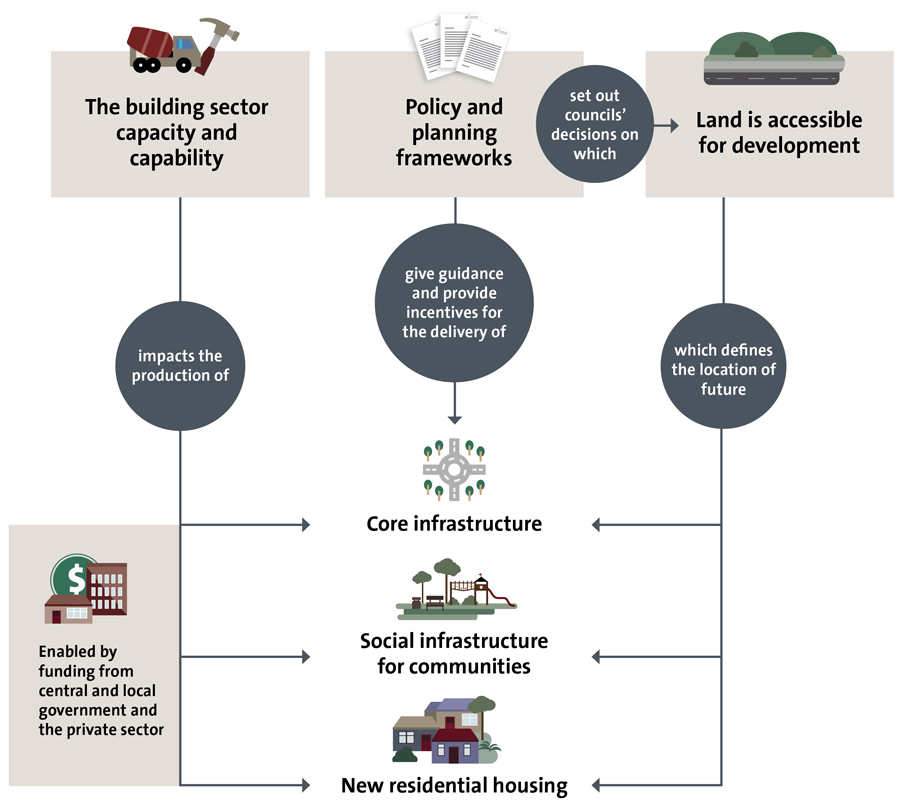The system
Housing and urban development: The challenges and our interest.

The system working in practice

Policy and planning frameworks
Key activities
- Setting direction and guidance
- Estimating and projecting growth
- Fulfilling obligations under the Resource Management Act 1991, Local Government Act 2002, and Land Transport Management Act 2008
- Planning how and where to accommodate growth
- Planning future investment in core infrastructure
- Working with Māori as Treaty partners to resolve housing challenges.
Agencies involved at this stage
- Councils
- Te Tūāpapa Kura Kāinga Ministry of Housing and Urban Development
- Kāinga Ora Homes and Communities
- Ministry for the Environment Manatū Mō Te Taiao
- Infrastructure Commission Te Waihanga
- Department of Internal Affairs Te Tari Taiwhenua
- Ministry of Transport Te Manatū Waka and Waka Kotahi NZ Transport Agency
- Te Puni Kōkiri.

Land accessible for development
Key activities
- Land is designated by councils
- Stakeholders are consulted
- Land is made available to purchase
- Planning for communities
- Working in partnership with iwi and community housing providers.
Agencies involved at this stage
- Councils
- Kāinga Ora
- Ministry of Housing and Urban Development
- Ministry for the Environment
- Land Information New Zealand Toitū Te Whenua.

Core infrastructure
Key activities
- Fostering and co-ordinating mutual commitment among agencies and partners
- Managing contracts and/or delivery
- Delivering core infrastructure (such as roads and water and wastewater pipes).
Agencies involved at this stage
- Councils
- Kāinga Ora
- Waka Kotahi and Ministry of Transport
- Ministry of Housing and Urban Development
- Infrastructure Commission.

Social infrastructure for communities
Key activities
- Working in partnership with social housing service providers
- Embedding social infrastructure to meet community needs
- Ensuring that social services and support are available.
Agencies involved at this stage
Many agencies, including:
- Councils
- Ministry of Housing and Urban Development
- Kāinga Ora
- Tāmaki Regeneration Company (Auckland)
- Ministry of Education
- District health boards
- Ministry of Social Development Te Manatū Whakahiato Ora.

New residential housing
Key activities
- Housing is designed
- Consenting is assessed and approved
- Houses are built
- Partnerships are formed with community housing providers.
Agencies involved at this stage
- Councils
- Ministry of Business, Innovation and Employment Hīkina Whakatutuki
- Ministry of Housing and Urban Development
- Kāinga Ora
- Tāmaki Regeneration Company (Auckland).

Building sector capability and capacity
Key activities
- Contracting with private sector firms
- Building/installing core infrastructure
- Building the physical assets that support social infrastructure
- Supporting education and training providers
- Building houses.
Agencies involved at this stage
- Waka Kotahi
- Kāinga Ora
- Ministry of Business, Innovation and Employment
- Ministry of Social Development
- Tertiary education institutions.
Next: Read about who does what
